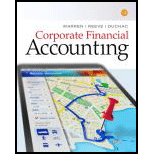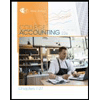
Bond discount, entries for bonds payable transactions
On July 1, Year 1, Danzer Industries Inc. issued $40,000,000 of 10-year, 7% bonds at a market (effective) interest rate of 8%, receiving cash of $37,282,062. Interest on the bonds is payable semiannually on December 31 and June 30. The fiscal year of the company is the calendar year.
Instructions
1.
2. Journalize the entries to record the following:
A. The first semiannual interest payment on December 31, Year 1, and the amortization of the bond discount, using the straight-line method. (Round to the nearest dollar.)
B. The interest payment on June 30, Year 2, and the amortization of the bond discount, using the straight-line method. (Round to the nearest dollar.)
3. Determine the total interest expense for Year 1.
4. Will the bond proceeds always be less than the face amount of the bonds when the contract rate is less than the market rate of interest?
5. (Appendix 1) Compute the price of $37,282,062 received for the bonds by using the present value tables in Appendix A at the end of the text. (Round to the nearest dollar.)
1.
Bonds: Bonds are long-term promissory notes that are represented by a company while borrowing money from investors to raise fund for financing the operations.
Bonds Payable: Bonds payable are referred to long-term debts of the business, issued to various lenders known as bondholders, generally in multiples of $1,000 per bond, to raise fund for financing the operations.
Discount on bonds payable: It occurs when the bonds are issued at a low price than the face value.
Straight-line amortization method: It is a method of bond amortization that spreads the amount of the bond discount equally over the interest period.
To prepare: Journal entry to record the amount of cash proceeds from the issuance of the bonds on July 1, Year 1.
Answer to Problem 11.1APR
Prepare journal entry for cash proceeds from the issuance of the bonds on July 1, Year 1.
| Date | Account Title and Explanation | Post Ref | Debit ($) | Credit ($) | |||
| July 1, Year 1 | Cash | 37,282,062 | |||||
| Discount on Bonds Payable (1) | 2,717,938 | ||||||
| Bonds Payable | 40,000,000 | ||||||
| (To record issuance of bonds payable at discount) | |||||||
Table (1)
Explanation of Solution
- Cash is an asset and it is increased. So, debit it by $37,282,062.
- Discount on Bonds Payable is an adjunct liability account and it is decreased. So, debit it by $2,717,938.
- Bonds payable is a liability and it is increased. So, credit it by $40,000,000.
Working note:
Calculate discount on bonds payable.
2.
A.
To prepare: Journal entry to record first interest payment and amortization of bond discount on December 31, Year 1.
Answer to Problem 11.1APR
Prepare journal entry for first interest payment and amortization of discount on bonds.
| Date | Account Title and Explanation | Post Ref | Debit ($) | Credit ($) | |||
| Year 1 | Interest Expense (4) | 1,535,897 | |||||
| December | 31 | Discount on Bonds Payable (2) | 135,897 | ||||
| Cash (3) | 1,400,000 | ||||||
| (To record semiannual payment of interest and amortization of discount on bonds) | |||||||
Table (2)
Explanation of Solution
- Interest expense is an expense and it decreases the equity value. So, debit it by $1,535,897.
- Discount on Bonds Payable is an adjunct liability account and it is increased. So, credit it by $135,897.
- Cash is an asset and it is decreased. So, credit it by $1,400,000.
Working notes:
Calculate discount on bonds payable semiannually.
Calculate the amount of cash interest.
Calculate the interest expense on the bond.
B.
To prepare: Journal entry to record second interest payment and amortization of bond discount on June 30, Year 2.
Answer to Problem 11.1APR
Prepare journal entry for second interest payment and amortization of discount on bonds.
| Date | Account Title and Explanation | Post Ref | Debit ($) | Credit ($) | |||
| Year 2 | Interest Expense (7) | 1,535,897 | |||||
| June | 30 | Discount on Bonds Payable (5) | 135,897 | ||||
| Cash (6) | 1,400,000 | ||||||
| (To record semiannual payment of interest and amortization of discount on bonds) | |||||||
Table (3)
Explanation of Solution
- Interest expense is an expense and it decreases the equity value. So, debit it by $1,535,897.
- Discount on Bonds Payable is an adjunct liability account and it is increased. So, credit it by $135,897.
- Cash is an asset and it is decreased. So, credit it by $1,400,000.
Working notes:
Calculate discount on bonds payable semiannually.
Calculate the amount of cash interest.
Calculate the interest expense on the bond.
3.
The amount of total interest expense for Year 1.
Explanation of Solution
Determine the amount of total interest expense for Year 1.
Hence, the amount of total interest expense for Year 1 is $1,535,897.
4.
To explain: The situation when contract rate of bond is less than the market rate of interest.
Answer to Problem 11.1APR
Yes, the bond proceeds will always be less than the face amount of bonds when the contract interest rate is less than the market interest rate.
Explanation of Solution
If the stated interest rate of a bond is less than the market interest rate, then the bonds is issued at discount. This is because the bonds is less valuable in market and investors is ready to pay less than the maturity value of bonds.
5.
To calculate: The amount of cash proceeds (present value) from the sale of the bonds using present value tables.
Explanation of Solution
Determine the amount of cash proceeds (present value) from the sale of the bonds.
Step 1: Calculate the semiannual interest on bonds.
Step 2: Calculate the present value of interest.
| Particulars | Amount |
| Interest payment (a) | $1,400,000 |
| PV factor at semiannual market interest rate of 4% for 20 periods (b) | 13.59033 |
| Present value
|
$19,026,462 |
Table (4)
Note: Refer Appendix A in the text book for present value factor.
Step 3: Calculate the present value of lump sum payment of $80,000,000 (principal amount) at 4% for 20 periods.
| Particulars | Amount |
| Single payment (a) | $40,000,000 |
| PV factor at semiannual market interest rate of 4% for 20 periods (b) | 0.45639 |
| Present value
|
$18,255,600 |
Table (5)
Note: Refer Appendix A in the text book for present value factor.
Step 4: Calculate the amount of cash proceeds from the sale of the bonds.
Thus, the amount of cash proceeds from the sale of the bonds is $37,282,062.
Want to see more full solutions like this?
Chapter 11 Solutions
Corporate Financial Accounting
- On Jan 1, Year 1, White Co grants its three top employees, Mr. Blue, Ms. Orange, and Mrs. Green, 3,000 options each to purchase its $10-par common stock. Each option allows the purchase of 10 shares at $25 per share during Years 3 and 4. In order for these options to be exercisable, each of the top employees must demonstrate a high level of performance during years 1 and 2. The fair market value of these options was $90,000. At that grant date, Mr. Blue declined the offer. How much will White record for compensation expense each year for years 1 and 2?arrow_forwardYellow Co foresees the possibility of being unsuccessful in a lawsuit that may result in incurring a major loss associated with its related liability. Which of the following is correct? A If it is remote, and a guarantee was given, a disclosure is necessary, but not an accrual. B If it is probable, a disclosure is necessary, but not an accrual. C If it is probable, an accrual is necessary but not a disclosure. D If it is reasonably possible, neither accrual nor disclosure is necessary.arrow_forwardAmber Inc has 200,000 shares of $10-par common stock outstanding and 4,000 shares of $50-par 8% convertible preferred stock outstanding. For 2024, Amber reported net income of $700,000 after deducting income taxes at a 30% rate. If each share of preferred stock is convertible into 1 share of common stock, what would Amer report for diluted earnings per share?arrow_forward
- Burgundy Corporation had made $56,000 of tax payments to the IRS. Its adjustments to increase its $502,000 pretax financial income netted $60,000 to arrive at taxable income. Assuming the tax rate is 25%, how much will Burgundy report for income taxes payable on its balance sheet?A$84,500 $125,500 $140,500 D $69,500arrow_forwardHarrison Home Maintenance bought equipment for $12,600 on January 1, 2020. It has an estimated useful life of six years and zero residual value. Harrison uses the straight-line method to calculate depreciation and records depreciation expense at the end of every month. As of June 30, 2020, the book value of this equipment shown on its balance sheet will be: A. $11,550 B. $12,600 C. $13,710 D. $12,930arrow_forwardPlease provide solution this general accounting questionarrow_forward
 College Accounting, Chapters 1-27AccountingISBN:9781337794756Author:HEINTZ, James A.Publisher:Cengage Learning,
College Accounting, Chapters 1-27AccountingISBN:9781337794756Author:HEINTZ, James A.Publisher:Cengage Learning, Excel Applications for Accounting PrinciplesAccountingISBN:9781111581565Author:Gaylord N. SmithPublisher:Cengage LearningPrinciples of Accounting Volume 1AccountingISBN:9781947172685Author:OpenStaxPublisher:OpenStax College
Excel Applications for Accounting PrinciplesAccountingISBN:9781111581565Author:Gaylord N. SmithPublisher:Cengage LearningPrinciples of Accounting Volume 1AccountingISBN:9781947172685Author:OpenStaxPublisher:OpenStax College Cornerstones of Financial AccountingAccountingISBN:9781337690881Author:Jay Rich, Jeff JonesPublisher:Cengage Learning
Cornerstones of Financial AccountingAccountingISBN:9781337690881Author:Jay Rich, Jeff JonesPublisher:Cengage Learning Financial AccountingAccountingISBN:9781305088436Author:Carl Warren, Jim Reeve, Jonathan DuchacPublisher:Cengage Learning
Financial AccountingAccountingISBN:9781305088436Author:Carl Warren, Jim Reeve, Jonathan DuchacPublisher:Cengage Learning College Accounting, Chapters 1-27 (New in Account...AccountingISBN:9781305666160Author:James A. Heintz, Robert W. ParryPublisher:Cengage Learning
College Accounting, Chapters 1-27 (New in Account...AccountingISBN:9781305666160Author:James A. Heintz, Robert W. ParryPublisher:Cengage Learning





